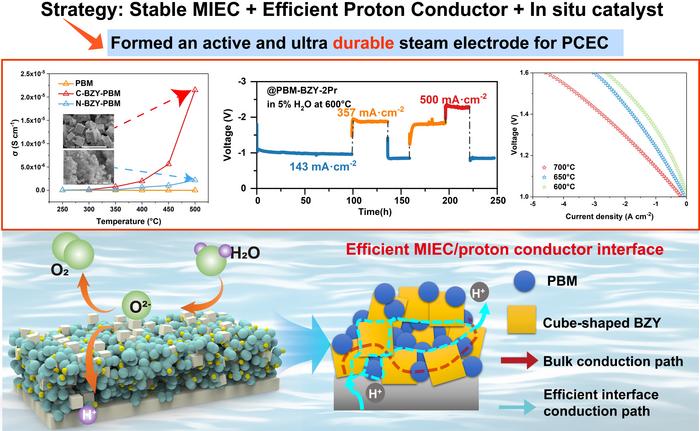Proton Ceramic Electrolyte Cells (PCECs) have been at the forefront of clean energy technologies, yet their commercial potential has faced significant challenges, primarily due to the need for durable and efficient electrodes capable of performing under harsh conditions. Research scientists have recently unveiled a breakthrough composite steam electrode that promises to overcome these obstacles and pave the way for enhanced energy conversion applications. This electrode comprised of a double perovskite structure, PrBaMn₂O₅+δ (PBM), and a robust proton conductor, BaZr₀.₈₅Y₀.₁₅O₃−δ (BZY), has shown remarkable advancements in stability and conductivity through innovative interface engineering.
The development of steam electrodes in PCECs is particularly significant because these devices hold the potential to transform how we generate and utilize energy. Traditional hydrogen production processes often rely on fossil fuels, which are increasingly viewed as unsustainable. PCECs present a cleaner alternative, utilizing water vapor and electricity to produce high-purity hydrogen. By introducing a steam electrode that operates efficiently even in high humidity conditions, researchers aim to facilitate broader adaptations of this technology within the energy sector.
One of the critical innovations in this recent study is the introduction of nano-sized PrOₓ catalysts, which have been deposited onto the PBM-BZY composite. This design enhances reaction kinetics at the electrode/electrolyte interface, leading to improved electrochemical performance. Tests revealed that the polarization resistance of the composite steam electrode was approximately 0.34 Ω·cm² at an operational temperature of 600 °C, which is competitive with traditional cobalt-based electrodes. Such low resistance indicates the electrode’s ability to maintain a high electrochemical activity, crucial for practical applications in PCECs.
Stability, particularly under severe conditions, remains a core focus in the evolution of PCECs. In experiments conducted over hundreds of hours, the newly developed composite steam electrode demonstrated exceptional durability without showing significant signs of degradation. This resilience is attributed to the structural integrity of the PBM and BZY materials, which, combined with the nano-catalysts, create a robust framework capable of withstanding the conditions typically encountered in energy conversion environments.
The research team analytically examined the electrode’s performance through various techniques, including X-Ray Diffraction (XRD), Scanning Electron Microscopy (SEM), Transmission Electron Microscopy (TEM), and Electrochemical Impedance Spectroscopy (EIS). Each method contributed critical insight into the stability of the phase structure and the overall electrochemical performance. The results consistently indicated that the composite electrode maintained superior electrical performance due to the unique structural properties enabled by the interface design.
A noteworthy finding from these analyses was the demonstration that the electrode comprising cube-shaped BZY microcrystals exhibited significantly higher proton conductivity—approximately 2.15×10⁻⁵ S·cm⁻¹ at 500 °C. This represents a full order of magnitude improvement over electrodes containing irregular nanosized BZY. The structured geometric arrangement of the cube-shaped particles not only promotes efficient ion transfer but also reinforces the electrode’s physical stability during operation, which is critical for long-term performance.
The effective interaction between the mixed ionic-electronic conductor (MIEC) and the proton conductor highlights the importance of interface engineering in the fabrication of composite electrodes. The dual-phase structure not only facilitates enhanced proton transfer, but it also opens up pathways for improved ionic conduction, demonstrating a significant leap forward in the design of electrochemically active materials. This advancement aligns well with the ongoing efforts to refine the efficiency and practicality of PCECs for future commercial applications.
In the realm of clean energy technologies, the importance of low operating temperatures cannot be overstated. The PCECs, with their demonstrated capabilities at temperatures as low as 700 °C, stand out against traditional solid oxide systems that typically require much higher operational temperatures. The researchers emphasize that this attribute could lead to reduced energy costs and improved overall system efficiency, fostering a faster transition to more sustainable energy solutions.
The publication of this research in the esteemed Journal of Advanced Ceramics on January 14, 2025, marks a significant milestone for the scientific community that focuses on energy conversion technologies. The insights gained from this study do not only contribute to the existing knowledge pool within the field but also present practical strategies for the engineering of next-generation electrodes aimed at facilitating the transition to renewable energy sources.
Lin Ge, the lead researcher at Nanjing Tech University, emphasized the broader implications of their findings, asserting that the interface-boosted electrode design can be adapted for various applications beyond just hydrogen production. The researchers are optimistic that these electrodes could play a crucial role in various energy conversion and storage technologies, ultimately supporting global efforts to reduce carbon emissions and combat climate change.
As we look toward a future where clean energy sources are prioritized, the development of composite steam electrodes such as the one described in this study represents a critical step forward. These innovative materials could be key to unlocking the full potential of Proton Ceramic Electrolyte Cells, ultimately leading to a more sustainable and environmentally friendly energy landscape.
Subject of Research: Development of ultra-durable composite steam electrodes for Proton Ceramic Electrolyte Cells
Article Title: Ultra durable composite steam electrode with cube-shaped BaZr₀.₈₅Y₀.₁₅O₃−δ facet-boosted efficiency toward advanced protonic ceramic electrolysis cells
News Publication Date: 14-Jan-2025
Web References: Journal of Advanced Ceramics
References: N/A
Image Credits: Credit: Journal of Advanced Ceramics, Tsinghua University Press
Keywords
Proton ceramic electrolyte cells; composite steam electrodes; clean energy technologies; hydrogen production; electrochemical performance; durability; interface engineering; sustainable energy conversion.
Tags: Okay





